Web Infantry Equipment, Pattern 1937
Bayonet Frogs
The Karkee Web Research Team would like to dedicate this page to the memory of the late Anthony Carter, part of whose life's work formed the inspiration for what KW has now expanded on here.
- nanos gigantum humeris insidentes
Stores Ref. A1/AA 0996 Frog, bayonet, W.E. Patt. ’37 (1st Issue)

 Described in the instructional pamphlet as being made from narrow webbing, the first issue of the Frog, bayonet, W.E. Patt. ’37, was the start of a very long story, complete with War Office clerical errors. The design goes back to a 1911 Patent, consisting of a body in 1 1/2-inch wide webbing, doubled and stitched to provide an accommodation of 2 1/4-inch for the Belt. An upper scabbard loop of webbing, 1 1/8-in. wide, was stitched onto the body, with a second loop of 1 1/2-in. wide webbing below. A loop of ½-inch webbing, stitched behind, inside the belt loop, formed a hilt retaining strap, to stop the Patt. ’07 bayonet, by then Bayonet, No. 1, from swaying too much.
Described in the instructional pamphlet as being made from narrow webbing, the first issue of the Frog, bayonet, W.E. Patt. ’37, was the start of a very long story, complete with War Office clerical errors. The design goes back to a 1911 Patent, consisting of a body in 1 1/2-inch wide webbing, doubled and stitched to provide an accommodation of 2 1/4-inch for the Belt. An upper scabbard loop of webbing, 1 1/8-in. wide, was stitched onto the body, with a second loop of 1 1/2-in. wide webbing below. A loop of ½-inch webbing, stitched behind, inside the belt loop, formed a hilt retaining strap, to stop the Patt. ’07 bayonet, by then Bayonet, No. 1, from swaying too much.
The photos at left show two early examples of the first issue Frog. The one on the right in the pictures was made by the Mills Equipment Company and is maker marked "M.E. Co." The slightly shorter example on the left in each picture is maker marked "M & S" (Marks and Spencer). Since both of these were supposed to be made to the same design, the difference in length should probably be attributed to a lack of quality control in new, wartime manufacturers such as M & S. Both of these Frogs are dated 1939, and are from the Carl Woods Collection. Photographs © Carl Woods 2009.
Stores Ref. None known Frog, bayonet, W.E. Patt. ’37 (2nd Issue)
![]()
 The Implement, Entrenching, Pattern 1908 had been made obsolete in 1923, so the British Army started the Second World War still without one. A new design, the Implement, entrenching, Patt. ’39 was then rapidly introduced – and abandoned! Instead, the old Implement, entrenching, Patt. ’08 was resurrected and re-designated as “…Patt. ‘37”. Just one problem – no Carrier. The Frog was therefore equipped with a tab, 7-inches x 1-inch, just as with Patt. ’08 Frog, to provide an attachment point for a re-designed Carrier, helve, implement, entrenching, Patt. ’37. The designation was not a reference to Patt. ’37 W.E. and it is therefore described under Associated Equipment. The Tabs, removed in 1923, were returned to Ordnance, to be held for the repair of ’08 Haversack flap straps. In 1920, the Articles for Repair included TABS, WEB, 1-in. x 6 3/4-in. For Haversack, O.S. & W.E. Patt. '08. In 1924, Articles for Repair had them as TABS, WEB, 1 inch, with brass tip, 7 inch, frog for intrenching tool attachment; also for haversack. These are, ostensibly, the same piece-parts. A revised design of Carrier was finally introduced, which carried both Head and Helve, so the tab was deleted. The markings and date on the Frog pictured at left are indecipherable. From the Graham Priest Collection. Photographs © Graham Priest 2009. You can see photos of this Frog, assembled with the Helve holder and the Entrenching tool Head carrier, on the Patt. '37 Entrenching Tool Carrier page.
The Implement, Entrenching, Pattern 1908 had been made obsolete in 1923, so the British Army started the Second World War still without one. A new design, the Implement, entrenching, Patt. ’39 was then rapidly introduced – and abandoned! Instead, the old Implement, entrenching, Patt. ’08 was resurrected and re-designated as “…Patt. ‘37”. Just one problem – no Carrier. The Frog was therefore equipped with a tab, 7-inches x 1-inch, just as with Patt. ’08 Frog, to provide an attachment point for a re-designed Carrier, helve, implement, entrenching, Patt. ’37. The designation was not a reference to Patt. ’37 W.E. and it is therefore described under Associated Equipment. The Tabs, removed in 1923, were returned to Ordnance, to be held for the repair of ’08 Haversack flap straps. In 1920, the Articles for Repair included TABS, WEB, 1-in. x 6 3/4-in. For Haversack, O.S. & W.E. Patt. '08. In 1924, Articles for Repair had them as TABS, WEB, 1 inch, with brass tip, 7 inch, frog for intrenching tool attachment; also for haversack. These are, ostensibly, the same piece-parts. A revised design of Carrier was finally introduced, which carried both Head and Helve, so the tab was deleted. The markings and date on the Frog pictured at left are indecipherable. From the Graham Priest Collection. Photographs © Graham Priest 2009. You can see photos of this Frog, assembled with the Helve holder and the Entrenching tool Head carrier, on the Patt. '37 Entrenching Tool Carrier page.
Stores Ref. A1/AA 0996 Frog, bayonet, W.E. Patt. ’37 (3rd Issue)
Later Stores Ref. CN/AA 0996 Web Equipment, Patt. ’37, Frog, bayonet (6th Issue)
Later still Stores Ref. CN/AA 0996 Web Equipment, Patt. ’37, Frog, bayonet, No. 5

 The long-delayed issue of Rifle No. 4 brought with it the much denigrated “spike” or “pig-sticker” bayonet, more correctly Bayonet No. 4. Its tubular scabbard was not a good fit in the existing Frog, so a device was created, the Tab, securing bayonet. This was not “Patt. ‘37”, since it was for use with Patt. ’08, if required, and anyway it was made from leather. It is described under Associated Equipment.
The long-delayed issue of Rifle No. 4 brought with it the much denigrated “spike” or “pig-sticker” bayonet, more correctly Bayonet No. 4. Its tubular scabbard was not a good fit in the existing Frog, so a device was created, the Tab, securing bayonet. This was not “Patt. ‘37”, since it was for use with Patt. ’08, if required, and anyway it was made from leather. It is described under Associated Equipment.
 The Tab, securing bayonet was an immediate solution to the problem of carrying the new bayonet. However, it can only be viewed as an interim answer, as what was really required was a new Frog. This came in A.C.I.375/1944, which detailed modifications to achieve this. The top scabbard loop was to be cut loose on one side and a buttonhole cut into it. The cut edges were to be reinforced by blanket stitching and the loop re-attached to the body. This created a Frog that would still take the No. 1 Bayonet, but the No. 4 Bayonet scabbard could be buttoned into the Frog as well. It is a modification that can be found on both 1st and 3rd Issue Frogs.
The Tab, securing bayonet was an immediate solution to the problem of carrying the new bayonet. However, it can only be viewed as an interim answer, as what was really required was a new Frog. This came in A.C.I.375/1944, which detailed modifications to achieve this. The top scabbard loop was to be cut loose on one side and a buttonhole cut into it. The cut edges were to be reinforced by blanket stitching and the loop re-attached to the body. This created a Frog that would still take the No. 1 Bayonet, but the No. 4 Bayonet scabbard could be buttoned into the Frog as well. It is a modification that can be found on both 1st and 3rd Issue Frogs.
 Not detailed in the comments is that it was a different frog to the 1st Issue Frog. The A.C.I. was accompanied by a dimensioned drawing (left), which reveals that the frog body and scabbard loops are all the same width – 11/4 inches, which is a quarter inch narrower on the body and lower scabbard loop and an eighth of an inch wider on the upper scabbard loop. Clearly, this was to simplify production and conformed to the Army’s Form, Fit & Function, so no new code was allocated – unfortunately for collectors. The Frog shown above left is maker marked "M.H.G." (Mary Harris Gowns) and dated 1944. At right above, the same Frog is shown with a second example that has the bayonet inserted and the Securing tab attached. That Frog is maker marked "T.T.C." (Teddy Toy Co.) and dated 1943. Both from the Graham Priest Collection. Photographs © Graham Priest 2009.
Not detailed in the comments is that it was a different frog to the 1st Issue Frog. The A.C.I. was accompanied by a dimensioned drawing (left), which reveals that the frog body and scabbard loops are all the same width – 11/4 inches, which is a quarter inch narrower on the body and lower scabbard loop and an eighth of an inch wider on the upper scabbard loop. Clearly, this was to simplify production and conformed to the Army’s Form, Fit & Function, so no new code was allocated – unfortunately for collectors. The Frog shown above left is maker marked "M.H.G." (Mary Harris Gowns) and dated 1944. At right above, the same Frog is shown with a second example that has the bayonet inserted and the Securing tab attached. That Frog is maker marked "T.T.C." (Teddy Toy Co.) and dated 1943. Both from the Graham Priest Collection. Photographs © Graham Priest 2009.


 By 1945, the Frog had its button hole woven-in during manufacture. The example at left, by Marks & Spencers, is dated 1945 and at last also has its Stores Code printed on it. Post-war, it would acquire the nomenclature Frog, bayonet, No. 5. Strictly speaking, being a different Frog, the woven slit made this Frog the 6th Issue (See Frog, No. 6 below). In 1951, L. of C. §C4686 placed this Frog under a sub-title, hence the reversal of nomenclature above. In 1953, L. of C. §C5936 introduced the Web Equipment, Patt. ’37, Frog, bayonet, No. 6 (see below), so by the same L. of C., CN/AA 0996 now became Web Equipment, Patt. ’37, Frog, bayonet, No. 5, simultaneously being made obsolete, with stocks to be used up. The coded 1945 dated Frog shown at left is from the Jonathan Paynter collection. For comparison, it is pictured at right beside a slightly shorter MECo example of 1952. Photographs © Jonathan Paynter, 2011
By 1945, the Frog had its button hole woven-in during manufacture. The example at left, by Marks & Spencers, is dated 1945 and at last also has its Stores Code printed on it. Post-war, it would acquire the nomenclature Frog, bayonet, No. 5. Strictly speaking, being a different Frog, the woven slit made this Frog the 6th Issue (See Frog, No. 6 below). In 1951, L. of C. §C4686 placed this Frog under a sub-title, hence the reversal of nomenclature above. In 1953, L. of C. §C5936 introduced the Web Equipment, Patt. ’37, Frog, bayonet, No. 6 (see below), so by the same L. of C., CN/AA 0996 now became Web Equipment, Patt. ’37, Frog, bayonet, No. 5, simultaneously being made obsolete, with stocks to be used up. The coded 1945 dated Frog shown at left is from the Jonathan Paynter collection. For comparison, it is pictured at right beside a slightly shorter MECo example of 1952. Photographs © Jonathan Paynter, 2011
Stores Ref. unknown Frog, web, bayonet, B.B.F. 162 type (4th Issue)

![]()
![]() The tubular scabbard of the new No. 4 Bayonet was an insecure and loose fit in existing Frogs. Mills therefore re-designed the Patt. ‘37 Frog in 1941, substituting an upper loop only 1/2-inch wide, set flush with the lower loop. This was not taken into service by the British Army, although Indian manufacture took place, but with the loops set 1/8 -inch apart. No nomenclature is known, so Anthony Carter’s reference of BBF 162 will have to suffice, though this referred only to Indian manufactured examples. The British example shown in the first picture, far left, is maker marked "M.E. Co." and dated 1941. It is from the John Bodsworth Collection, © John Bodsworth 2009. The pictures centre and near left show an Indian example of this Frog. It is maker marked "Ca" and dated 1943, and is from the Roger Dennis Collection, photos © Roger Dennis 2009.
The tubular scabbard of the new No. 4 Bayonet was an insecure and loose fit in existing Frogs. Mills therefore re-designed the Patt. ‘37 Frog in 1941, substituting an upper loop only 1/2-inch wide, set flush with the lower loop. This was not taken into service by the British Army, although Indian manufacture took place, but with the loops set 1/8 -inch apart. No nomenclature is known, so Anthony Carter’s reference of BBF 162 will have to suffice, though this referred only to Indian manufactured examples. The British example shown in the first picture, far left, is maker marked "M.E. Co." and dated 1941. It is from the John Bodsworth Collection, © John Bodsworth 2009. The pictures centre and near left show an Indian example of this Frog. It is maker marked "Ca" and dated 1943, and is from the Roger Dennis Collection, photos © Roger Dennis 2009.
Stores Ref. A1/AA 5101 Frog, web, bayonet, No. 4, W.E., Patt. ‘37 (5th issue)
Stores Ref. CN 0994 Web Equipment, Patt. ’37, Frog, web, bayonet, No. 4
Stores Ref. A1/AA 5508 Frog
Together with
Stores Ref. A1/AA 5508 Case, plate, retainer
Stores Ref. B3/BE 8532 Holder, plate, cover B3 Machine Carbines & Accessories
Stores Ref. A4/AD 0356 Holder, base-plate, Sten gun
![]()
![]()
![]()
![]() The Frog, web, bayonet, No. 4, W.E., Patt. ‘37 constitutes the 5th Issue of Bayonet frog, though it only achieved “Patt. ’37 W.E.” status in 1951. In between, it suffered a form of identity crisis, not to say a split personality. Something this insignificant ought not to be so complicated!
The Frog, web, bayonet, No. 4, W.E., Patt. ‘37 constitutes the 5th Issue of Bayonet frog, though it only achieved “Patt. ’37 W.E.” status in 1951. In between, it suffered a form of identity crisis, not to say a split personality. Something this insignificant ought not to be so complicated!
BBF 162 formed the basis for a 5th Issue, now with a 1/4-inch gap between the loops. It also had a new feature, a ¾-inch wide tab stitched vertically to the lower scabbard loop. This was woven with an eyelet, which fitted over the No. 4 scabbard stud, where it protruded between the loops, thus locking it into the Frog, as the Tab, securing, bayonet had once done. There was no hilt loop, as it was designed for the No. 4 Bayonet. With no wartime document seen, Drawing No. D.D.(E) 3682 (referred to below) at least provides Frog, No. 4 Bayonet (with the single comma) as a valid nomenclature. Although it was Not In Vocabulary, it was allocated Stores Ref. A1/AA 5101. The example shown in the two photos far left is maker marked "A.C." (Associated Cutters) and dated 1944. Shown near left is an example of Frog Stores Ref. A1/AA 5508 (see below). As can be seen, these two Frogs are identical except for the nomenclature. This Frog is also maker marked "A.C.", and is dated 1945. Both Frogs are from the Martin Brayley Collection, photographs © Martin Brayley 2005.
When L. of C. §C4686 rationalised wartime codes into new CN codes, it then acquired a badly punctuated nomenclature of CN/AA 0994 Web Equipment, Patt. ’37, Frog, web, bayonet, No. 4, which would lead to later confusion. In 1951 it was listed as an alternative to CN/AA 0996 Web Equipment, Patt. ’37, Frog, bayonet. What jars with this is an earlier Contract entry, noted by KWRT member Carl Woods, where it is named as Frog bayonet No. 5 Rifle, un-punctuated as shown, from which it follows that the Frog was for the No. 5 Bayonet. The No. 5 started life as a lightweight No. 4 Rifle, later colloquially (but not officially) known as the “Jungle Carbine”. Airborne units have been noted carrying the No. 5 Rifle, in Norway, the Far East and the Victory Parade in London. The No. 5’s scabbard was also used for Nos. 7, 9 and L1A1 S.L.R. bayonets.



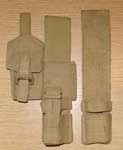 On Drawing No. D.D.(E.) 3682, date 22 January 1944, the same design is referred to as Frog, No. 4 Bayonet, and Case, plate, retainer, Sten 9-mm. This is the colloquially termed “Airborne Frog”, the Case being a small pocket, in which the Sten Mk. V Retainer Plate was carried. When paratroops broke the Sten down, by removing the Butt, the Plate was inserted to stop the Breech Block and Return spring, etc, falling out. The June 1944 edition of Parts List for Carbine, machine, Sten, 9-mm., Mk. V illustrates this frog / pocket combination, together with a No. 4 Mk. II* Bayonet. Simply named as Frog, the Stores Code is rendered as “A1/AA” with no number and the pocket has no nomenclature, or code. Despite this, these assemblies had both parts marked as A1/AA 5508. On the example shown left, both pieces are maker marked "A.C." (Associated Cutters) and date 1945. The photo at right shows this Frog, assembled, compared with the Indian made Frog BBF 162 shown above. All from the Roger Dennis Collection, photographs © Roger Dennis 2009.
On Drawing No. D.D.(E.) 3682, date 22 January 1944, the same design is referred to as Frog, No. 4 Bayonet, and Case, plate, retainer, Sten 9-mm. This is the colloquially termed “Airborne Frog”, the Case being a small pocket, in which the Sten Mk. V Retainer Plate was carried. When paratroops broke the Sten down, by removing the Butt, the Plate was inserted to stop the Breech Block and Return spring, etc, falling out. The June 1944 edition of Parts List for Carbine, machine, Sten, 9-mm., Mk. V illustrates this frog / pocket combination, together with a No. 4 Mk. II* Bayonet. Simply named as Frog, the Stores Code is rendered as “A1/AA” with no number and the pocket has no nomenclature, or code. Despite this, these assemblies had both parts marked as A1/AA 5508. On the example shown left, both pieces are maker marked "A.C." (Associated Cutters) and date 1945. The photo at right shows this Frog, assembled, compared with the Indian made Frog BBF 162 shown above. All from the Roger Dennis Collection, photographs © Roger Dennis 2009.

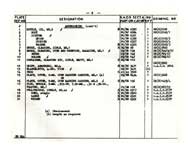
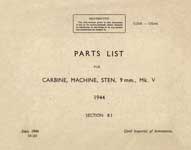 Airborne specific items had been separated, as Section A4 Airborne Equipment, from V.A.O.S. Section A1 Steel Helmets and Accoutrements, which were primarily Infantry items. The Case, plate, retainer was specifically an Airborne item. The December 1944 edition of V.A.O.S. Section B3, another new Section, had separated the Case and revised its nomenclature to B3/BE 8532 Holder, plate, cover. In an echo of the Contract nomenclature, A1/AA 5508 Frog, scabbard, bayonet, Mk. 5 was also listed above, with a hand-written annotation A1/AA 5101 Frog. There was no “Mark 5” Scabbard, though there was a Mark 5 Sten Gun. It is therefore assumed it should have read “…No. 5…”. The addition of the 5101 entry recognises the basis for the airborne assembly, therefore confirming that 5508 was an assembly code. The 1946 edition of the Sten V Parts List (extract shown left) adds the code A1/AA 5508, still only listing “Frog”, with no reference to the case, or a code for it, which should have at least have been B3/BE 8532, if not an A4 code. The 1948 edition of Section A4 at last corrected this, also now revised to A4/AD 0356 Holder, base-plate, Sten gun – its third nomenclature. No Frog was listed under A4, since this was A1/AA 5101 – the un-necessary 5508 code having at last been dropped. The complete 1944 Parts List for the Sten Mk. V is available here as an Adobe PDF file. Click on the cover picture shown right above to access it. As usual with Karkee Web's PDF files, you'll need to use your web browser's back button to return to this page. This manual, as well as the plates from the 1946 Parts List also shown above left, are from the Bart Temmink Collection and are provided courtesy of Bart Temmink.
Airborne specific items had been separated, as Section A4 Airborne Equipment, from V.A.O.S. Section A1 Steel Helmets and Accoutrements, which were primarily Infantry items. The Case, plate, retainer was specifically an Airborne item. The December 1944 edition of V.A.O.S. Section B3, another new Section, had separated the Case and revised its nomenclature to B3/BE 8532 Holder, plate, cover. In an echo of the Contract nomenclature, A1/AA 5508 Frog, scabbard, bayonet, Mk. 5 was also listed above, with a hand-written annotation A1/AA 5101 Frog. There was no “Mark 5” Scabbard, though there was a Mark 5 Sten Gun. It is therefore assumed it should have read “…No. 5…”. The addition of the 5101 entry recognises the basis for the airborne assembly, therefore confirming that 5508 was an assembly code. The 1946 edition of the Sten V Parts List (extract shown left) adds the code A1/AA 5508, still only listing “Frog”, with no reference to the case, or a code for it, which should have at least have been B3/BE 8532, if not an A4 code. The 1948 edition of Section A4 at last corrected this, also now revised to A4/AD 0356 Holder, base-plate, Sten gun – its third nomenclature. No Frog was listed under A4, since this was A1/AA 5101 – the un-necessary 5508 code having at last been dropped. The complete 1944 Parts List for the Sten Mk. V is available here as an Adobe PDF file. Click on the cover picture shown right above to access it. As usual with Karkee Web's PDF files, you'll need to use your web browser's back button to return to this page. This manual, as well as the plates from the 1946 Parts List also shown above left, are from the Bart Temmink Collection and are provided courtesy of Bart Temmink.
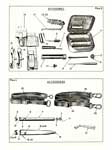
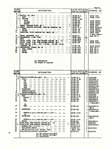 The 1951 Parts List for Carbine, machine, Sten, 9-mm., Mk. V illustrated two bayonet scabbards, Nos. 4 and 5. The No. 5 Bayonet did not fit the Sten Mk. V, but the No. 7 Bayonet – a fighting knife – had a rotating hilt, so that it could be attached to this specific Mark of Sten, which had a protruding barrel akin to that of the No. 4 Rifle. The Frog was still just that, A1/AA 5508 Frog, still with no mention of the slip-on pocket for the Marks 1 and 2 Plates, cover, illustrated alongside and coded, respectively B3/BE 8434 and B3/CR 142. L. of C. §C4686, also in 1951, amended A1/AA 5101. The 1946 B3 listing shows that A1/AA 5508 was an Assembly Code, stamped on in the factory. This is ignorance, as Assembly Codes are not usually marked-on – where would you stamp say an entire assembled Man Pack Frame, G.S.? It is an accounting / indenting convenience for the Quartermaster, etc. It would have made far more sense for the Case / Holder alone to be AA 5508, rather than B3/BE 8532. The plates from the 1951 Parts List also shown left are from the Bart Temmink Collection, provided courtesy of Bart Temmink.
The 1951 Parts List for Carbine, machine, Sten, 9-mm., Mk. V illustrated two bayonet scabbards, Nos. 4 and 5. The No. 5 Bayonet did not fit the Sten Mk. V, but the No. 7 Bayonet – a fighting knife – had a rotating hilt, so that it could be attached to this specific Mark of Sten, which had a protruding barrel akin to that of the No. 4 Rifle. The Frog was still just that, A1/AA 5508 Frog, still with no mention of the slip-on pocket for the Marks 1 and 2 Plates, cover, illustrated alongside and coded, respectively B3/BE 8434 and B3/CR 142. L. of C. §C4686, also in 1951, amended A1/AA 5101. The 1946 B3 listing shows that A1/AA 5508 was an Assembly Code, stamped on in the factory. This is ignorance, as Assembly Codes are not usually marked-on – where would you stamp say an entire assembled Man Pack Frame, G.S.? It is an accounting / indenting convenience for the Quartermaster, etc. It would have made far more sense for the Case / Holder alone to be AA 5508, rather than B3/BE 8532. The plates from the 1951 Parts List also shown left are from the Bart Temmink Collection, provided courtesy of Bart Temmink.
 The Airborne Frog was separated between two V.A.O.S. Sections, its Frog (AA 5101) to the Infantry Section A1 and the Airborne specific Case, or Holder (AD 0356) to Section A4. The assembly code A1/AA 5508 therefore disappeared, though no documentation has been found to this effect. The Holder was made obsolete by L. of C. §C7375, approved on 30 May, 1956. The photo left shows the complete assembly - the Frog with the Bayonet No. 4. The Frog is maker marked "M.E. Co." and dated 1945. The Case, plate, retainer is also maker marked "M.E. Co.", and is dated 1944. From the Allen Prior Collection, photograph © Allen Prior 2009. .
The Airborne Frog was separated between two V.A.O.S. Sections, its Frog (AA 5101) to the Infantry Section A1 and the Airborne specific Case, or Holder (AD 0356) to Section A4. The assembly code A1/AA 5508 therefore disappeared, though no documentation has been found to this effect. The Holder was made obsolete by L. of C. §C7375, approved on 30 May, 1956. The photo left shows the complete assembly - the Frog with the Bayonet No. 4. The Frog is maker marked "M.E. Co." and dated 1945. The Case, plate, retainer is also maker marked "M.E. Co.", and is dated 1944. From the Allen Prior Collection, photograph © Allen Prior 2009. .
Stores Ref. CN/AA 0997 Web Equipment, Patt. ’37, Frog, bayonet, No. 6 (7th Issue)
![]()
![]() The reader should now be thoroughly confused: Frog Nos. 4 and 5? What were Frog Nos. 1 to 3? The answer to that is there weren’t any! The War Office were never too hot with English syntax and seemingly lacked an absolute understanding of their inverted forms of nomenclature.
The reader should now be thoroughly confused: Frog Nos. 4 and 5? What were Frog Nos. 1 to 3? The answer to that is there weren’t any! The War Office were never too hot with English syntax and seemingly lacked an absolute understanding of their inverted forms of nomenclature.
When L. of C. §C4686 listed Frog, web, bayonet, No. 4, the War Office clerks were simply trying to say it was a Frog for the Bayonet No. 4. Their use of web was largely redundant, since the leather frogs were earlier in the A1/AA sequence, which began at A1/AA 0944 and ran through black, brown and buff bayonet frogs, Sam Browne frogs, wirecutter frogs, etc. The web frogs opened at A1/AA 0995 for the Patt. ’08 W.E. Frog and would eventually reach CN/AA 0998 – all of them web.
Subsequent clerks evidently looked back and interpreted this as the 4th Web Frog, so when L. of C. §C5936 introduced an even “leaner manufactured” frog, they saw that CN 0994 was allocated as No. 4, but they had an existing CN 0996, so they gave the new frog CN 0997, realised they’d better call its now obsolete predecessor No. 5, in succession to No. 4 and so called the new frog Web Equipment, Patt. ’37, Frog, bayonet, No. 6.
It differed from previous Frogs in having a single scabbard loop, in 2 1/2-inch wide webbing, with a woven-in button hole for the studs of either the No. 4 Scabbard, or the No. 5 Scabbard, used with No. 5, 7, 9 and F.N. 7.62-mm. S.L.R. bayonets. The No. 6 Frog was the final new component ever added to Patt. ’37 W.E. The example shown here is maker marked "M" and dated 1954. From the John Bodsworth Collection. Photographs © John Bodsworth 2009.
Rather late in the day, a COSA entry for this Frog has been noted. It states that it is “…olive drab…”, which can hardly be confused with “drab”, or khaki. The entry is in the 1976 edition, but the 1965 CCN entry makes no reference to its colour